

Presentation Created by: Tony Giordano, Ph.D. Chief Scientific Officer Inquiries, Please Contact: 1 (800) 400-2247 ir@janone.com Exhibit 99.1
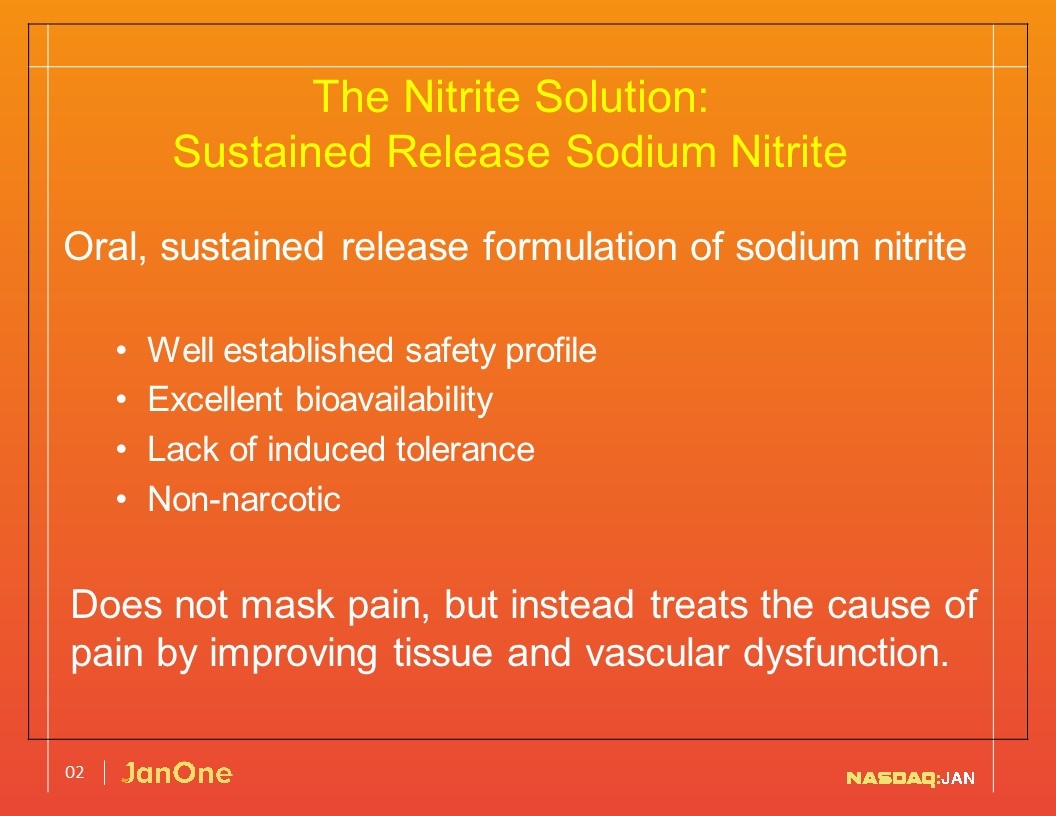
The Nitrite Solution: Sustained Release Sodium Nitrite Oral, sustained release formulation of sodium nitrite Well established safety profile Excellent bioavailability Lack of induced tolerance Non-narcotic Does not mask pain, but instead treats the cause of pain by improving tissue and vascular dysfunction. 02

Plasma Nitrite Levels are Negatively Correlated to Cardiovascular Disease Plasma nitrite levels were inversely related to number of cardiovascular risk factors a subject had and decreased plasma nitrite was associated with decreased flow mediated vasodilation (FMD) and increased intimal medial thickness (IMT) (both indicators of vascular pathology). -Kleinbongard, et al. (2006) Free Radic Biol and Medicine 40:295-302 03

Plasma Nitrite Levels are Reduced In Diabetic and PAD Patients Exercise is a well known stimulator of eNOS activity, NO production that leads to increased plasma nitrite. In the study by Allen et al, these authors revealed that baseline plasma levels of nitrite were less in patients with diabetes mellitus (DM) or DM + PAD. Importantly, increases in plasma nitrite levels were not observed in either DM, PAD or DM + PAD patients after supervised exercise. These data reveal that baseline nitrite availability is compromised in DM patients and that supervised exercise is unable to increase plasma nitrite levels but actually results in a decrease in nitrite highlighting a physiological deficiency of this molecule. -Allen et al Nitric Oxide 2009 20:231-237 04

Skeletal Muscle Nitrite and Metabolite Levels are Reduced in Critical Limb Ischemia Patients Skeletal muscle nitrite, nitrosothiol, nitric oxide-heme and cGMP are all significantly reduced in CLI patients. Diabetic patients with CLI show even further nitrite reductions. 05

Sodium Nitrite and Sustained Release Nitrite: Preclinical Data 06

Nitrite and Sustained Release Nitrite: Preclinical Data Highly selective Promotes blood vessel growth Prevents diabetic nephropathy Stimulates wound healing Prevents tissue necrosis 07

Nitrite Therapy Selectively Increases Ischemic Tissue Vascular Density in an NO-dependent Manner Chronic sodium nitrite therapy increases ischemic tissue vascular density in an NO-dependent manner. A and B show representative images of CD31 (red) and DAPI nuclear (blue) staining from sodium nitrite and sodium nitrate ischemic gastrocnemius muscle tissue at day 7. C and D report the vascular density of ischemic gastrocnemius muscle tissue at days 3 and 7 for 165 μg/kg sodium nitrite and nitrate treatments, respectively. E and F demonstrate the vascular density of ischemic gastrocnemius muscle tissue at days 3 and 7 from 165 μg/kg sodium nitrite plus carboxy PTIO. (Scale bar, 150 μm.) n = 10 mice per treatment group. Kumar D. et al. PNAS; 2008; 105:7540-7545. 08
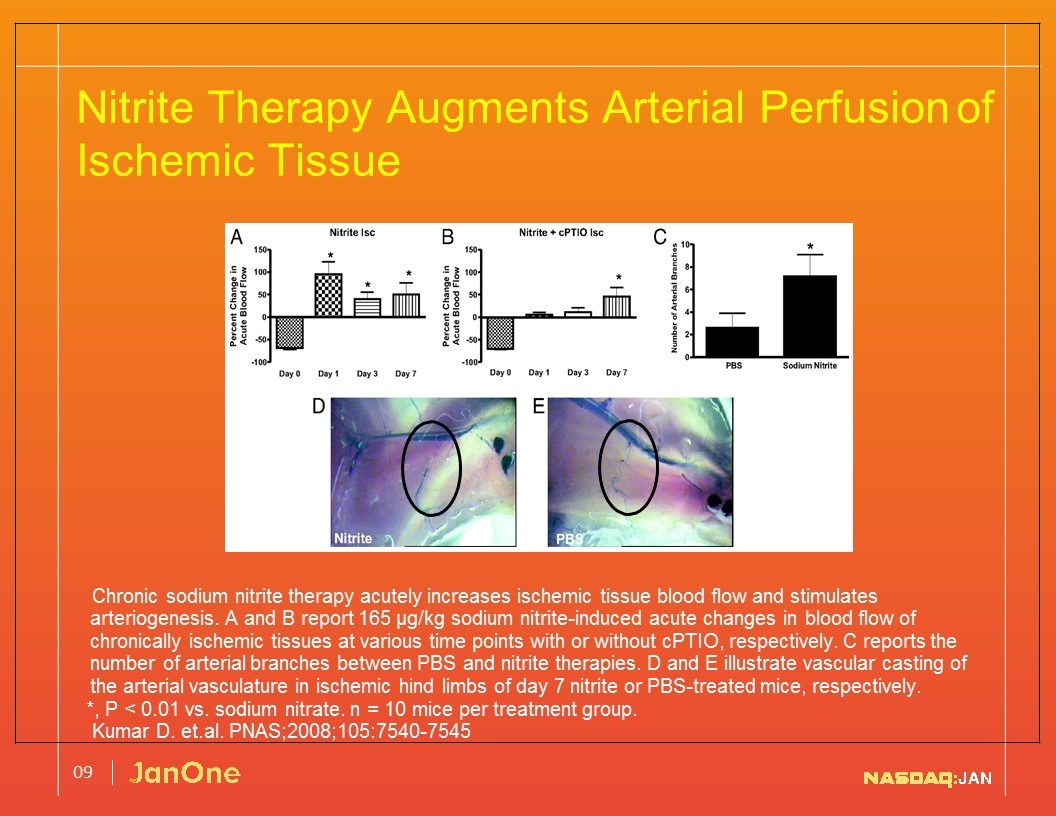
Nitrite Therapy Augments Arterial Perfusion of Ischemic Tissue Chronic sodium nitrite therapy acutely increases ischemic tissue blood flow and stimulates arteriogenesis. A and B report 165 μg/kg sodium nitrite-induced acute changes in blood flow of chronically ischemic tissues at various time points with or without cPTIO, respectively. C reports the number of arterial branches between PBS and nitrite therapies. D and E illustrate vascular casting of the arterial vasculature in ischemic hind limbs of day 7 nitrite or PBS-treated mice, respectively. *, P < 0.01 vs. sodium nitrate. n = 10 mice per treatment group. Kumar D. et.al. PNAS;2008;105:7540-7545 09

Nitrite Therapy Restores Diabetic Ischemic Hind-Limb Blood Flow and Promotes Wound Healing Unilateral femoral artery ligation was performed on 18-20 week old male Db/Db mice. Mice were randomized to PBS or sodium nitrite (165 μg/kg) therapy twice daily via I.P. injection. Laser doppler flowmetry was performed at the indicated ****time points. Increased wound dehiscence was noted in the PBS treated animals at day 7 but not *in nitrite treated animals. (Bir et al Diabetes 2014, 63(1):270-81) 10

Nitrite Therapy Increases Diabetic Ischemia Induced Angiogenesis PBS NI PBS Isch Nitrite NI Nitrite Isch 0.0 0.5 1.0 Angiogenic Index PBS NI PBS Isc Nitrite NI Nitrite Isc C57BL/6J * * Db/Db BKS* Nitrite therapy prevented ischemia mediated endothelial cell density loss in normal C57BL/6J ischemic limbs. Nitrite therapy significantly restored endothelial cell density in ischemic limbs of diabetic mice to normal C57BL/6J levels compared to PBS therapy of non-ischemic and ischemic conditions. These data suggest that nitrite therapy may be useful in attenuating microvascular rarefaction due to loss of nitric oxide that is observed during metabolic dysfunction (Frisbee JC AJP Integr Comp Physiol 2005 289(2):R307-16; Stepp et al Microcirculation 2007 14(4-5): 311-6) 11

Delayed Nitrite Therapy Restores Ischemic Hind-Limb Blood Flow Day 0 Pre Day 0 Post Day 1 Day 3 Day 5 Day 7 Day 14 Day 21 60 40 80 100 Delayed Nitrite Therapy Nitrite (165 mg/kg) PBS * * Start Percent Blood Flow (mLLD/min/100g) Studies were performed to determine whether nitrite mediated therapy would be effective in tissue that had been left ischemic for 5 days after femoral artery ligation. Femoral artery ligation was performed in C57BL/6J mice and the animals randomized to either PBS or sodium nitrite therapy 5 days after artery ligation. Treatments were given b.i.d. via I.P. injection. Ischemic limb blood flow was measured using laser doppler flowmetry. (Bir et al Diabetes 2014, 63(1):270-81) 12
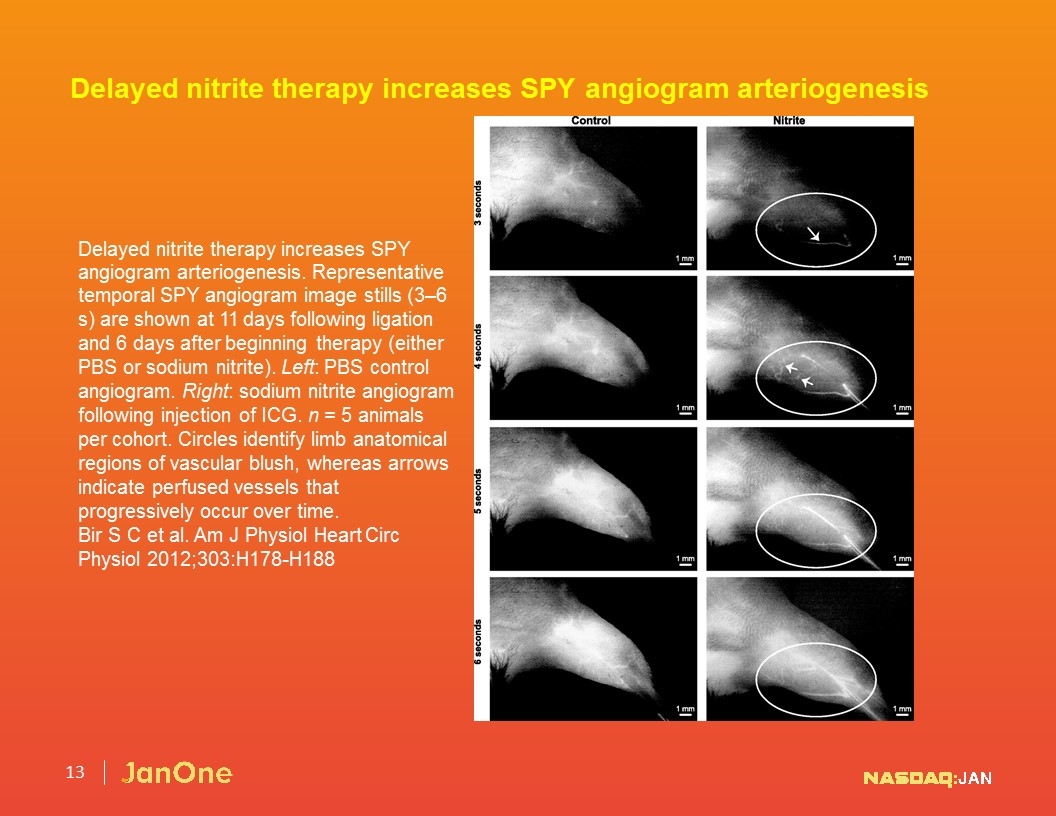
Delayed nitrite therapy increases SPY angiogram arteriogenesis Delayed nitrite therapy increases SPY angiogram arteriogenesis. Representative temporal SPY angiogram image stills (3–6 s) are shown at 11 days following ligation and 6 days after beginning therapy (either PBS or sodium nitrite). Left: PBS control angiogram. Right: sodium nitrite angiogram following injection of ICG. n = 5 animals per cohort. Circles identify limb anatomical regions of vascular blush, whereas arrows indicate perfused vessels that progressively occur over time. Bir S C et al. Am J Physiol Heart Circ Physiol 2012;303:H178-H188 13

Nitrite Therapy Prevents Diabetic Nephropathy in Rats Control Diabetic Diabetic + Nitrite Serum Glucose 105 363 344 Nitrite/Nitrate 11.5 2.5 11.0 Renal Collagen 2.7 5.7 3.3 Blood Urea Nitrogen (BUN) 19.2 98.2 34.6 Serum Creatinine 0.6 1.7 0.8 Urine Protein 5 84 20 Serum Cholesterol 61 160 157 From Arya et al (2011) Mol Cell Biochem 354:57-66 14

Nitrite Therapy Prevents Tissue Necrosis in Aged Db/Db Mice Delayed sodium nitrite (165 ug/kg) or control PBS therapy was stated 5 days post femoral artery ligation in 9 month old Db/Db mice. Nitrite therapy significantly prevented tissue necrosis (panel B) compared to control PBS therapy (panel A). Panel D reports tissue necrosis severity as a function of degree of limb and digit involvement. Nitrite therapy but not PBS control or sodium nitrate significantly prevented tissue necrosis. (Bir et al Diabetes 2014, 63(1):270-81) 15

• • • • Nitrite and Hind Limb Ischemia Summary Single one-time nitrite therapy does not stimulate angiogenesis. Delayed nitrite therapy effectively restores ischemic tissue blood flow. Nitrite therapy is effective in a wide range of pathologies involving alterations of angiogenesis including diabetes, wound healing and tissue necrosis. Beneficial effects center on enhancing angiogenesis, endothelial cell proliferation, and arteriogenesis. 16

Development of JAN101:A Sustained Release Formulation of Sodium Nitrite Animal data supports improved efficacy. Sustained release formulation have been developed at the University of Iowa. One of these formulations has been scaled up for manufacturing and used in clinical studies. 17

Sustained Nitrite Delivery is Superior to Bolus Nitrite Injection for Ischemic Limb Blood Flow Restoration Ischemic limb blood flow was measured using laser doppler flowmetry on mice with alzet minipump implantation versus I.P. injection. These data clearly reveal that sustained nitrite delivery using alzet minipumps quickly increased and sustained ischemic limb blood flow compared to nitrite I.P. injection that was more gradual. Interestingly, continuous lower dose nitrite delivery using minipumps was not effective at restoring blood flow above that of PBS therapy or I.P. injection route. 18

Sustained Nitrite Delivery is More Potent for Ischemic Vascular Growth Ischemic tissues were harvested at day 5 to determine whether continuous nitrite therapy augmented ischemic vascular growth over b.i.d IP injection of sodium nitrite. Both nitrite delivery formats significantly increased vascular density in the ischemic limb. However, alzet minipump delivery of nitrite significantly increased vessel density over that of nitrite b.i.d. IP injection of nitrite. **p<0.01 versus PBS, ***p<0.001 versus PBS, line with **p<0.01 165 ug/kg alzet vs 165 ug/kg bid injection, n=6. 19

Sustained Nitrite Delivery Increases Levels of Circulating Nitrite and Metabolites Serum nitrite, nitrosothiol and cGMP all increased in nitrite treated animals. Cardiac nitrite levels are not changed but nitrosothiol levels are increased. 20

Sustained Nitrite Therapy Prevents Cardiac Dysfunction Brain Natriuretic Peptide (BNP) is a peptide produced in the heart and are increased in heart failure (Panel A). BNP remains low after nitrite therapy (Panel A). During heart failure the heart hypertrophies or increases in size.Nitrite therapy prevents hypertrophy (Panel B). Lungs also hypertrophy during heart failure, and nitrite prevents this (Panel C). 21

Sustained Nitrite Therapy Prevents Cardiac Dysfunction, cont. Diastolic and systolic cardiac dilatation are increased in heart failure.Nitrite significantly inhibited this (Panels D and E). A major problem in heart failure is a significant drop in the Ejection Fraction. Nitrite prevented this drop (Panel F). 22

Delayed Nitrite Therapy also Improves Cardiac Function Nitrite therapy was delayed for 3 weeks following the Transverse Aortic Constriction. A major problem in heart failure is a significant drop in the Ejection Fraction.Nitrite prevented this drop (Panel F). 23

Summary of Sustained Release Animal Data Sustained release of nitrite resulted in faster and more robust angiogenesis in Hind Limb Ischemia model of PAD. Sustained release of nitrite resulted in improved cardiac function in Transverse Aortic Constriction model of heart failure, whereas bolus release was inactive. Thus, sustained release nitrite should improve efficacy in human subjects and reduce side effects since high CMax will be eliminated. 24

Development of Sustained Release Formulations: in vitro Dissolution 0 2 6 8 10 4 Time % 100.0% 90.0% 80.0% 70.0% 60.0% 50.0% 40.0% 30.0% 20.0% 10.0% 0.0% Formulation 9 Formulation 1 Development of various sustained release formulations was carried out in Dr. Douglas Flanagan’s lab at the University of Iowa A number of the formulations resulted in very good in vitro release kinetics 25

Manufacturable Formulation Developed Composition 80 mg sodium nitrite HPMC Lactose PVP k30 magnesium stearate. Testing carried out Purity (uv spec) Dissolution 24-hour release 0% 20% 40% 60% 80% 100% 120% 0 1 2 3 6 7 8 9 % Dissolution 45 Time (hour) Sodium Nitrite Dissolution 26

80 mg Sustained Release Tablets Manufactured Tested in CLI Model in Ossabaw Pigs Ossabaw pigs fed a high cholesterol diet to induce obesity and diabetes Common and external iliac arteries occluded for 14 days Randomized to placebo or 80 mg JAN101 (sustained release) Femoral blood pressure and doppler ultrasound measured weekly 27

Sustained Release Nitrite Increases Plasma Circulating Levels of Nitrite Following occlusion of the artery, plasma nitrite levels dropped in control animals. Nitrite treatment increased nitrite levels over time. 28

Sustained Release NitriteIncreases Circulating RSNO RSNO is a down stream marker of nitric oxide activity. Following occlusion of the artery, plasma RSNO levels in placebo animals dropped slightly. Nitrite treatment significantly increased RSNO levels indicating an increase in nitric oxide activity. 29
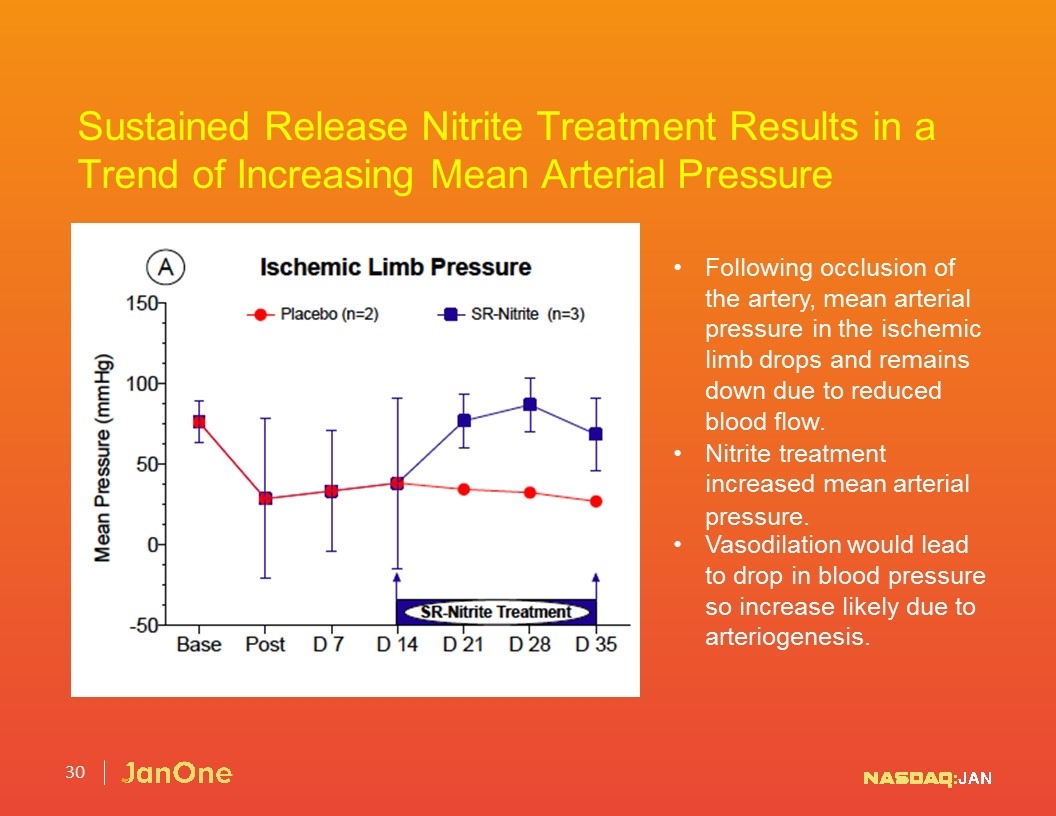
Sustained Release Nitrite Treatment Results in a Trend of Increasing Mean Arterial Pressure Following occlusion of the artery, mean arterial pressure in the ischemic limb drops and remains down due to reduced blood flow. Nitrite treatment increased mean arterial pressure. Vasodilation would lead to drop in blood pressure so increase likely due to arteriogenesis. 30

Sustained Release Nitrite Treatment Results in a Trend of Increasing Luminal Artery Area Doppler ultrasound was used to measure superficial femoral artery vessel area. Following occlusion of the artery, luminal area was reduced. Nitrite treatment increased luminal area. 31

Sustained Release Nitrite Treatment Results in a Trend toward Increasing Angiogenesis Representative, magnified-view contrast angiography was carried out at different times following occlusion. Hind limb vessel density was acquired by angiographic score of the magnified-view contrast angiographic images . Quantitative angiographic analysis revealed a significant reduction in perfusion of the CLI limb (p < 0.01) in the placebo group when compared to the control limb; however, no reduction was observed in the Nitrite treated animals. Placebo Nitrite 32

Sustained Release Nitrite Treatment Increases Markers of Angiogenesis VEGF mRNA levels are significantly increased (p < 0.05) in the ischemic limb following Nitrite treatment and protein levels show a strong trend towards increasing. CD31 mRNA levels show a trend towards increasing following Nitrite treatment (p=0.051) and the protein levels are significantly increased. 33

24 Hour Telemetry Showed No Change in Systolic or Diastolic Blood Pressure following Treatment with Sustained Release Nitrite Ossabaw pigs fed a high-fat diet result in a hypertensive phenotype. Graphical representation of daily AM and PM averages of blood pressure and heart rate using radiotelemetry in the conscious animal was measured starting 14 days prior to critical limb ischemia surgery and continued for 35 days post. 34

Summary of Sustained Release Nitrite Formulation Work Various formulations developed with strong in vitro dissolution properties The manufactured formulation resulted in positive observations in Ossabaw pig CLI study No change in blood pressure Significant increase in biomarkers of angiogenesis Strong trend toward actual increase in angiogenesis Have established GMP manufacturing protocols for sustained release nitrite (40 and 80 mg) 35

Sodium Nitrite & Sustained Release Sodium Nitrite: Clinical Data 36
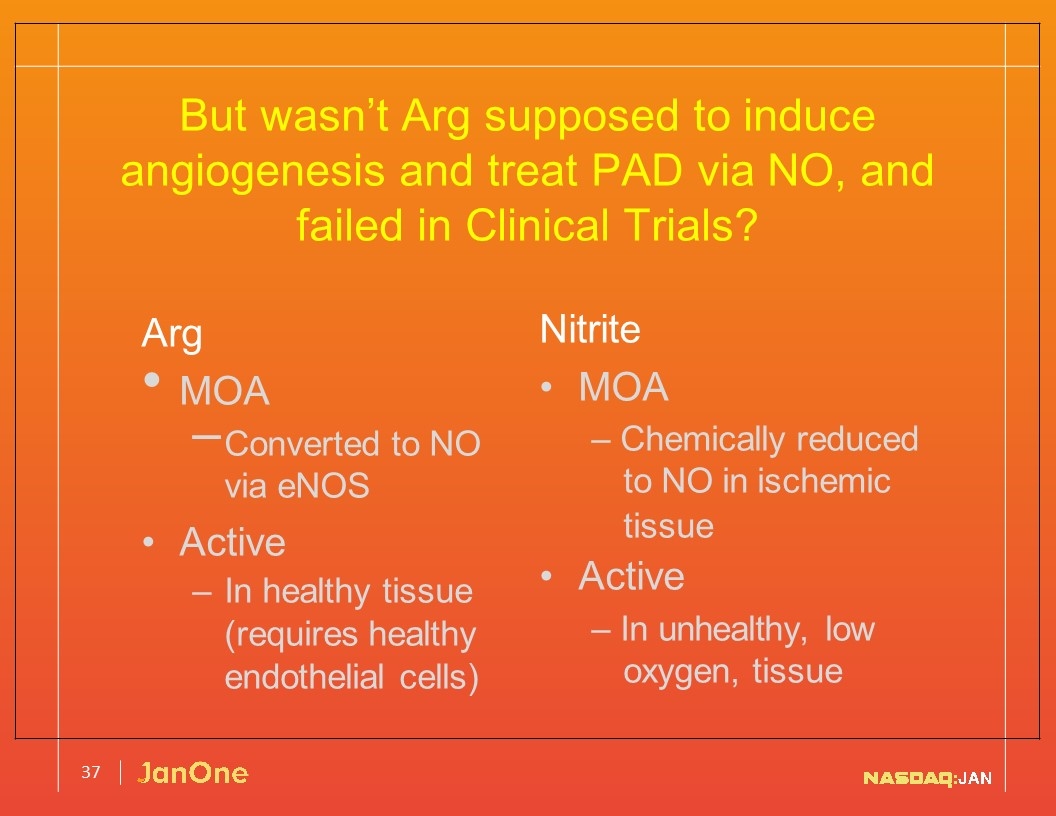
But wasn’t Arg supposed to induce angiogenesis and treat PAD via NO, and failed in Clinical Trials? ArgNitrite MOA•MOA Converted to NO– Chemically reduced via eNOSto NO in ischemic Activetissue In healthy tissue•Active (requires healthy– In unhealthy, low endothelial cells)oxygen, tissue 37
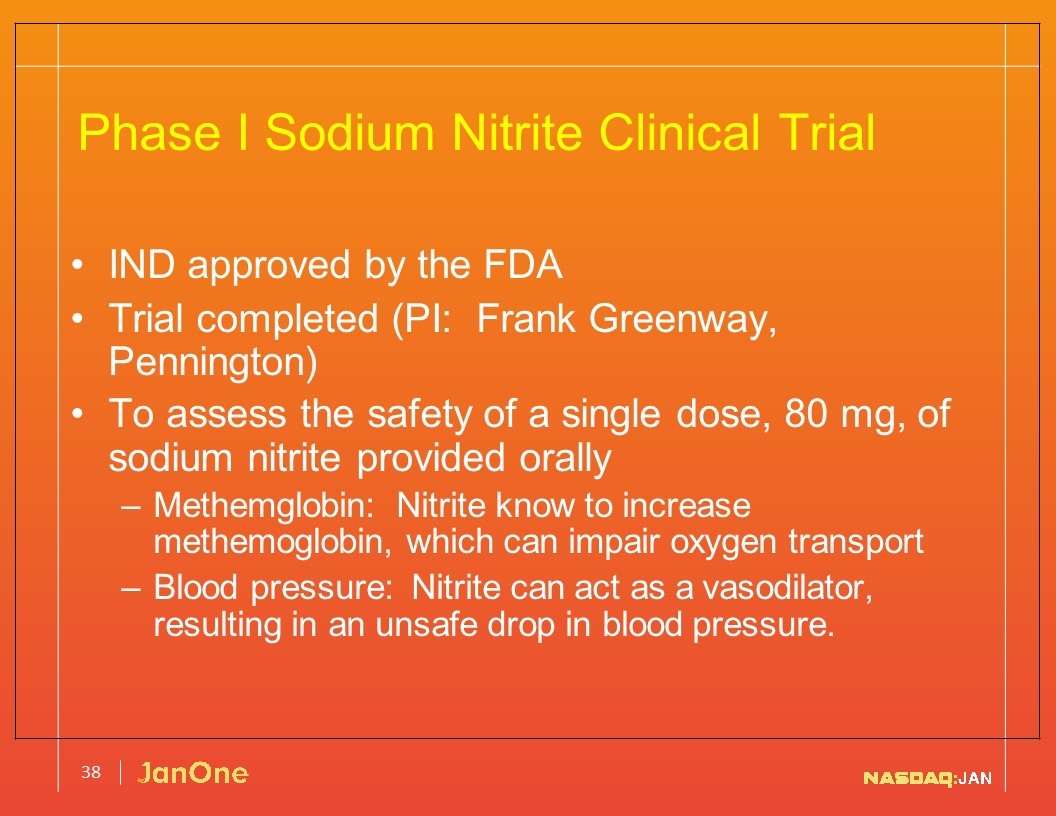
Phase I Sodium Nitrite Clinical Trial IND approved by the FDA Trial completed (PI:Frank Greenway, Pennington) To assess the safety of a single dose, 80 mg, of sodium nitrite provided orally Methemglobin:Nitrite know to increase methemoglobin, which can impair oxygen transport Blood pressure:Nitrite can act as a vasodilator, resulting in an unsafe drop in blood pressure. 38

Blood Levels Correspond to Effective PK Observed in Mice In mouse studies, a Cmax of ~2.7 mM with rapid clearance provided for twice daily resulted in activity described in animal studies In the Phase I study, a single oral administration of nitrite resulted in a Cmax of ~4.1 mM, with rapid clearance 39

Sodium Nitrite Does not Increase Methemoglobin Levels -Greenway et al Diabetes Technol Ther 2012 Nitrite is currently used to treat cyanide poisoning wherein the nitrite binds reversibly to globin preventing cyanide from binding irreversibly. This binding activity of nitrite to hemoglobin also leads to a major side effect, methemoglobinemia, which can cause headaches, dizziness and even comas when levels are increased significantly. Blood was collected every hour during the study to measure changes in percent methemoglobin. No increases in methemoglobin were observed with the 80-mg dose administered in this study. 40

Sodium Nitrite Causes an Asymptomatic, Transient Drop in Blood Pressure * * * -Greenway et al Diabetes Technol Ther 2012 Nitrite can also lead to vasodilation and a significant drop in blood pressure. To assess whether the 80-mg dose lead to a significant drop in blood pressure, blood pressure was measured regularly for 6 hours after administration of the sodium nitrite. Although, there was a significant drop in systolic blood pressure at 1.0 and 1.25 hours (p<0.001) and in the diastolic blood pressure at 1 hour (p<0.003), the drop was from 125/78 to 115/72 and was asymptomatic and returned to basal levels by 2h. 41

Phase I Study Conclusion 80 mg is safe and well tolerated 80 mg results in blood levels predicted to be therapeutic (4.1 observed mM vs 2.5 mM predicted) Change in blood pressure was asymptomatic and resolved quickly without treatment 42

Phase IIa PAD Study of Sodium Nitrite (SONIC Trial) Placebo controlled, dose raging study to evaluate the safety, pharmacokinetics, and tolerability of multiple doses of oral sodium nitrite in patients with PAD. 40 and 80 mg doses, BID 10 week treatment period, followed by 1 week dose escalation Primary Objective:Safety and Tolerability Primary Endpoint:Flow Mediated Dilation (FMD) Secondary Objectives:Pharmacokinetics and evidence of functional improvement: Quality of Life 6 minute walk distance Analysis of biomarkers 43

Phase IIa Enrollment 55 Subjects enrolled 10 Clinical Sites University of Pennsylvania Emory Medical School Cleveland Clinic University of Cincinnati Medical College of Wisconsin University of Colorado The Ohio State University Vanderbilt University of Iowa University Hospitals 44

Demographic Data Placebo40*mg80*mg n=18n=19n=18 Age at informed consent (years)64.9 +/9 8.9865.3 +/9 8.8667.9 +/9 9.99 GenderMale13(72.2%)15(78.9%)13(72.2%) Female5(27.8%)4(21.1%)5(27.7%) Race/Ethnicity Black or African American5(27.8%)6(31.6%)8(44.4%) White12(66.7%)12(63.2%)10(55.6%) Other1(5.6%)1(5.3%)0(0.0%) Weight(kg)88.07 +/9 27.2479.32 +/9 13.5388.99 +/9 16.70 Height(cm)173.18 +/9 13.29172.01 +/9 9.87172.18 +/9 9.95 Screening BMI (kg/m2)29.32 +/9 8.3126.71 +/9 2.9930.01 +/9 5.03 ABI in index limb at screening0.56 +/9 0.150.62 +/9 0.200.69 +/9 0.17 Diabetes Diagnosis10(55.6%)14(73.7%)14(77.8%) Hb A1c (% Hb) at screening6.97 +/9 1.486.99 +/9 1.276.71 +/9 0.94 No differences between treatment groups Most subjects were diabetic ABI was relatively low (0.56-0.69) suggesting subjects exhibited fairly severe PAD 45
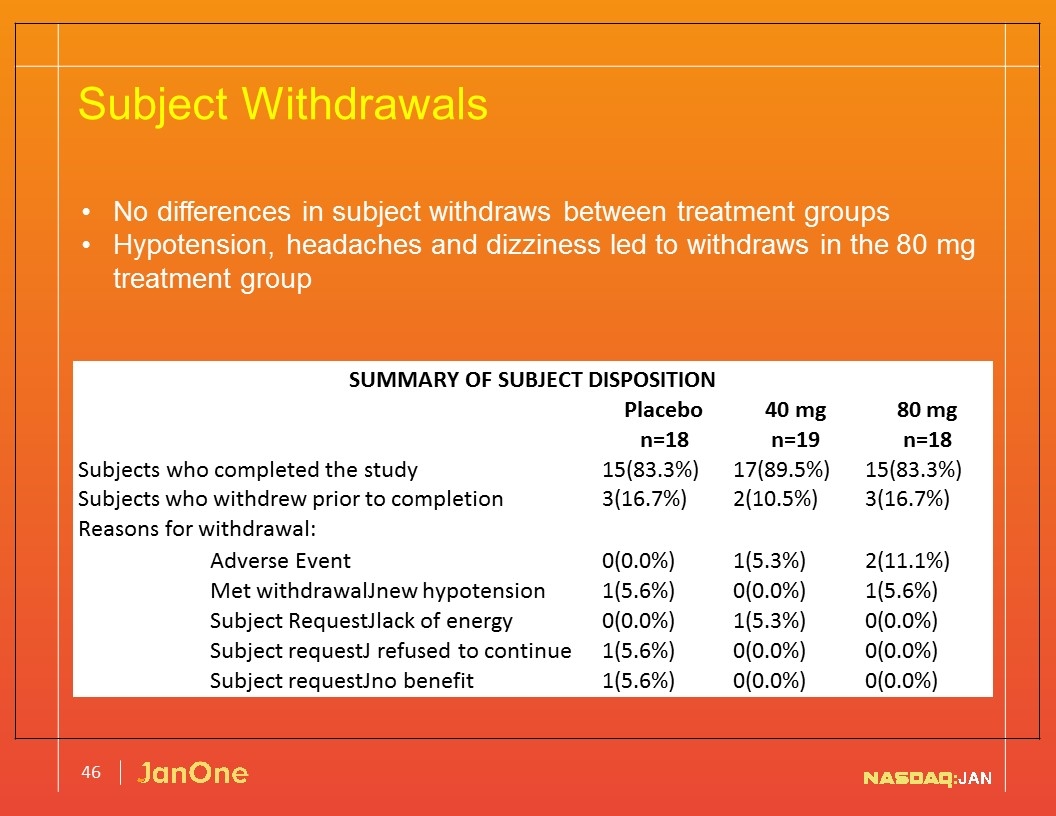
Subject Withdrawals No differences in subject withdraws between treatment groups Hypotension, headaches and dizziness led to withdraws in the 80 mg treatment group SUMMARY OF SUBJECT DISPOSITION Placebo40 mg80 mg n=18n=19n=18 Subjects who completed the study15(83.3%)17(89.5%)15(83.3%) Subjects who withdrew prior to completion3(16.7%)2(10.5%)3(16.7%) Reasons for withdrawal: Adverse Event0(0.0%)1(5.3%)2(11.1%) Met withdrawalJnew hypotension1(5.6%)0(0.0%)1(5.6%) Subject RequestJlack of energy0(0.0%)1(5.3%)0(0.0%) Subject requestJ refused to continue1(5.6%)0(0.0%)0(0.0%) Subject requestJno benefit1(5.6%)0(0.0%)0(0.0%) 46

Safety Data: Adverse Events 2 SAEs Reported, both in Placebo group 50%, 63% and 78% of subjects reported at least one AE in the placebo, 40 and 80 mg groups, respectively Headaches and dizziness were the adverse events likely related to treatment, with 44% reported by patients in the 80 mg group Placebo40 mg80 mg Blood and lymphatic system disorders001(5.6%) Cardiac disorders02(10.5%)0 Eye disorders002(11.1%) GI disorders4(22.2%)2(10.5%)3(16.7%) General disorders02(10.5%)1(5.6%) Infections and intestations1(5.6%)2(10.5%)1(5.6%) Injury, poisoning and procedural complications03(15.8%)0 Investigations3(16.7%)1(5.3%)3(16.7%) Musculoskelatal and connective tissue disorders2(11.1%)3(15.8%)2(11.1%) Neoplasms benign, malignant and unspecified001(5.6%) Nervous system disorders (not incl. headaches/dizziness)1(5.6%)2(10.5%)2(11.1%) Headaches and dizziness04(21.0%)8(44.4%) Renal and urinary disorders02(10.5%)0 Respiratory, thoracic and mediastinal disorders2(11.1%)01(5.6%) Skin and subcutaneous tissue disorders1(5.6%)01(5.6%) Vascular disorders1(5.6%)03(16.7%) 47
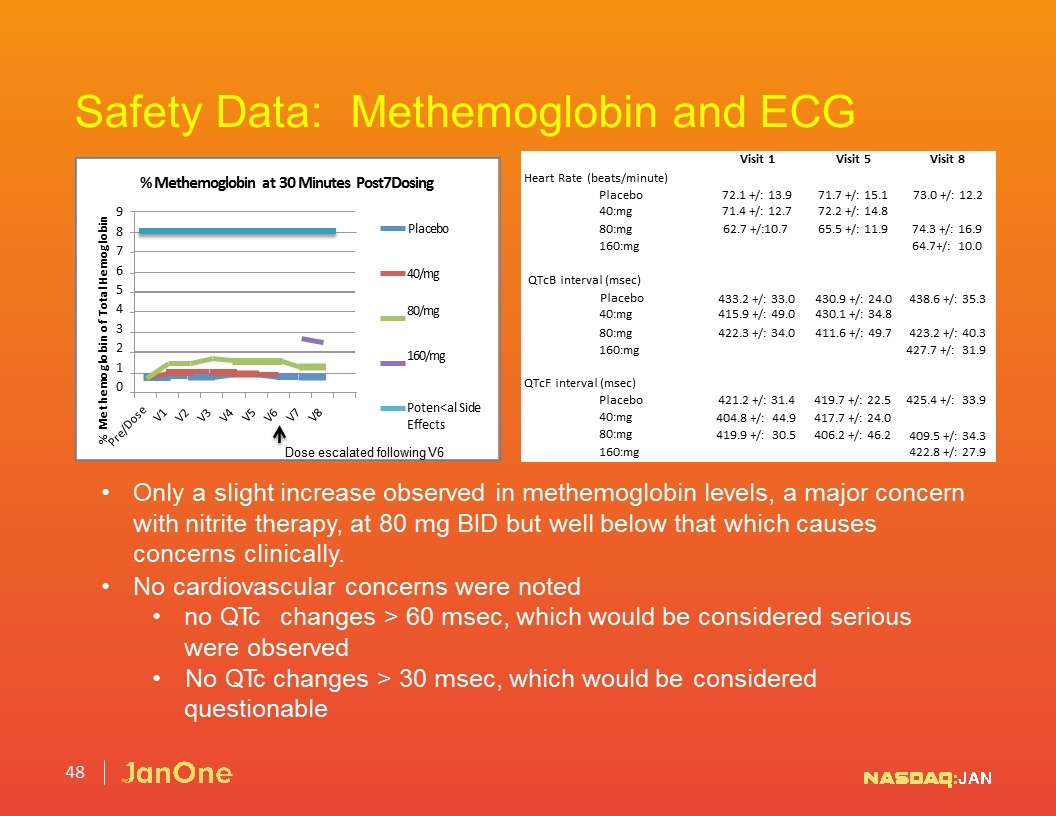
Safety Data:Methemoglobin and ECG 9 8 7 6 5 4 3 2 1 0 Pre/Dose V1 V2 V3 V4 V5 V6 V7 V8 % Methemoglobin of Total Hemoglobin % Methemoglobin at 30 Minutes Post7Dosing Placebo 40/mg 80/mg 160/mg Poten<al Side Effects Dose escalated following V6 Heart Rate (beats/minute) Placebo Visit 1 72.1 +/: 13.9 Visit 5 71.7 +/: 15.1 Visit 8 73.0 +/: 12.2 40:mg 71.4 +/: 12.7 72.2 +/: 14.8 80:mg 160:mg 62.7 +/:10.7 65.5 +/: 11.9 74.3 +/: 16.9 64.7+/: 10.0 QTcB interval (msec) Placebo 433.2 +/: 33.0 430.9 +/: 24.0 438.6 +/: 35.3 40:mg 415.9 +/: 49.0 430.1 +/: 34.8 80:mg 160:mg 422.3 +/: 34.0 411.6 +/: 49.7 423.2 +/: 40.3 427.7 +/: 31.9 QTcF interval (msec) Placebo 40:mg 80:mg 421.2 +/: 31.4 404.8 +/: 44.9 419.9 +/: 30.5 419.7 +/: 22.5 417.7 +/: 24.0 406.2 +/: 46.2 425.4 +/: 33.9 409.5 +/: 34.3 160:mg 422.8 +/: 27.9 Only a slight increase observed in methemoglobin levels, a major concern with nitrite therapy, at 80 mg BID but well below that which causes concerns clinically. No cardiovascular concerns were noted no QTcchanges > 60 msec, which would be considered serious were observed No QTc changes > 30 msec, which would be considered questionable 48
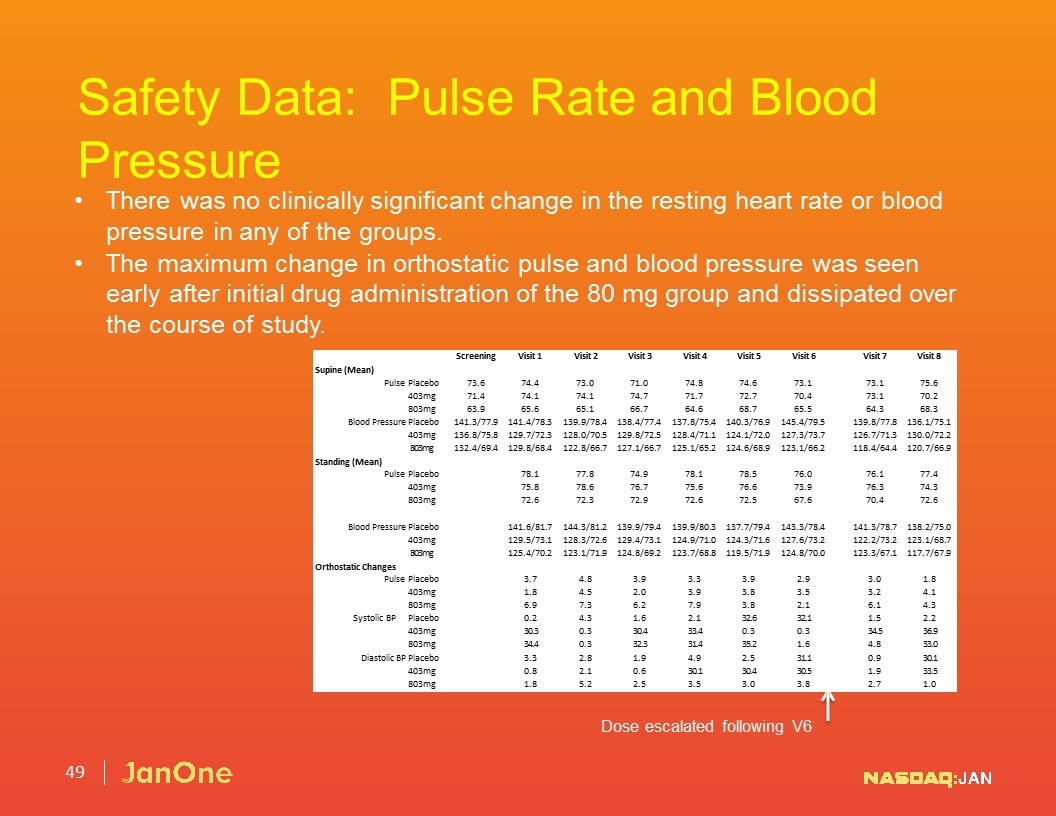
Safety Data:Pulse Rate and Blood Pressure Dose escalated following V6 Supine (Mean) Screening Visit 1 Visit 2 Visit 3 Visit 4 Visit 5 Visit 6 Visit 7 Visit 8 Pulse Placebo 73.6 74.4 73.0 71.0 74.8 74.6 73.1 73.1 75.6 403mg 71.4 74.1 74.1 74.7 71.7 72.7 70.4 73.1 70.2 803mg 63.9 65.6 65.1 66.7 64.6 68.7 65.5 64.3 68.3 Blood Pressure Placebo 141.3/77.9 141.4/78.3 139.9/78.4 138.4/77.4 137.8/75.4 140.3/76.9 145.4/79.5 139.8/77.8 136.1/75.1 403mg 136.8/75.8 129.7/72.3 128.0/70.5 129.8/72.5 128.4/71.1 124.1/72.0 127.3/73.7 126.7/71.3 130.0/72.2 803mg Standing (Mean) 132.4/69.4 129.8/68.4 122.8/66.7 127.1/66.7 125.1/65.2 124.6/68.9 123.1/66.2 118.4/64.4 120.7/66.9 Pulse Placebo 78.1 77.8 74.9 78.1 78.5 76.0 76.1 77.4 403mg 75.8 78.6 76.7 75.6 76.6 73.9 76.3 74.3 803mg 72.6 72.3 72.9 72.6 72.5 67.6 70.4 72.6 Blood Pressure Placebo 141.6/81.7 144.3/81.2 139.9/79.4 139.9/80.3 137.7/79.4 143.3/78.4 141.3/78.7 138.2/75.0 403mg 129.5/73.1 128.3/72.6 129.4/73.1 124.9/71.0 124.3/71.6 127.6/73.2 122.2/73.2 123.1/68.7 803mg Orthostatic Changes 125.4/70.2 123.1/71.9 124.8/69.2 123.7/68.8 119.5/71.9 124.8/70.0 123.3/67.1 117.7/67.9 Pulse Placebo 3.7 4.8 3.9 3.3 3.9 2.9 3.0 1.8 403mg 1.8 4.5 2.0 3.9 3.8 3.5 3.2 4.1 803mg 6.9 7.3 6.2 7.9 3.8 2.1 6.1 4.3 Systolic BPPlacebo 0.2 4.3 1.6 2.1 32.6 32.1 1.5 2.2 403mg 30.3 0.3 30.4 33.4 0.3 0.3 34.5 36.9 803mg 34.4 0.3 32.3 31.4 35.2 1.6 4.8 33.0 Diastolic BP Placebo 3.3 2.8 1.9 4.9 2.5 31.1 0.9 30.1 403mg 0.8 2.1 0.6 30.1 30.4 30.5 1.9 33.5 803mg 1.8 5.2 2.5 3.5 3.0 3.8 2.7 1.0 There was no clinically significant change in the resting heart rate or blood pressure in any of the groups. The maximum change in orthostatic pulse and blood pressure was seen early after initial drug administration of the 80 mg group and dissipated over the course of study. 49

Biological Activity Data:FMD 2 1 0 !1 !2 !3 !4 !5 !6 Diabe<c Difference in % Change from Baseline FASPer!Protocol Exploratory Popula7on Change in Flow Mediated Dila7on (Least Square Means) Placebo 40!mg 80!mg In the intent-to-treat population there was no significant difference in FMD at baseline among the groups. The difference in FMD from baseline was assessed at 10 weeks and a non- significant trend was noted for worsening of FMD in the placebo and 40 mg bid group whereas maintenance of baseline FMD was observed in the 80 mg bid group. In the diabetic cohort, the change in FMD in those receiving the 80 mg bid dose was significantly greater than those receiving placebo and 40 mg bid dose (P< 0.01). Flow Mediated Dilation is a ideal imaging modality to assess endothelial cell dysfunction Brian Annex has shown that FMD is severely compromised in diabetic patients Since the mechanism of action of nitrite is to improve endothelial cell function, FMD was used to assess biological activity 50

Biological Activity Data:6 Minute Walk 150 100 50 0 !50 !100 !150 FAS Diabe4c Feet Per!Protocol Popula+on Change in Walking Distance (Least Square Means) Placebo 40!mg 80!mg The 40 mg bid dose group showed a numeric improvement in the 6 minute walk test over time compared to placebo but this was not statistically significant. The mean improvement in the Per-Protocol group was 57 feet and the median improvement was 99 feet. The main complaint associated with PAD, in the inability to walk even short distances without pain. The 6 minute walk test measures the distance a subject can walk up and down a corridor in 6 minutes. This test was conducted to determine the number of subjects needed to power the next trial. 51

!10 !15 !20 15 10 5 0 !5 25 20 PhysicalLimita2ons dueEnergy/Fa2gue Improvement General Health Func2oningto Physicalin Pain ScaleHealth Change from Baseline Score Rand 36 Ques8onnaire: Physical (Least Square Means) Placebo 40!mg 80!mg Biological Activity Data: Quality of Life (QoL) * P < 0.05 There was a significant improvement in the pain domain for physical component of SF 36 questionnaire (P<0.05) among patients randomized to 40 mg group compared with placebo. Limitations due to pain in the affected leg leads to poor quality of life. A RAND 36 Quality of Life Questionnaire and Walking Impairment Questionnaire were used to assess improvements in QoL. This test was conducted to determine the number of subjects needed to power the next trial. 52

Study Conclusions No clinical safety concerns Clear evidence of biological activity Indication of clinical outcome for treating PAD patients but Dose dependent increases in headaches and dizziness may have contributed to subjects in the 80 mg group performing worse in the 6 minute walk test and their assessment of quality of life. Sustained release formulation should provide clinical benefits while reducing headaches and dizziness, which track the high Cmax of the rapid release formulation 53

Phase IIa:Sodium Nitrite Effects on Aging Doug Seals Ph.D., Univ. of Colorado Has shown that vascular function declines with age beginning at 50 years old Received R21 grant Following SONIC protocol, except: Healthy subjects aged 50-85 Replaced 6 minute walk with time to exhaustion on treadmill Had a number of secondary endpoints Received an RO1 grant to study 40 mg sodium nitrite sustained release vs placebo in 34 subjects per group 54

Sodium Nitrite Improves Flow Mediated Dilation in Healthy Subjects Brachial artery flow-mediated dilation (FMD) was improved with 10 weeks sodium nitrite supplementation (80 mg/day bar middle bars, 160 mg/day right most bars) compared with placebo (left most bars). Values are means ± SE. * P ≤ 0.10 Placebo vs Low Dose (80 mg/day). 55

Reduction in Flow Mediated Dilation is Associated with Reduced Oxidative Stress Placebo BaselineWeek 10 Nitrite 80 mg/d BaselineWeek 10 The improvement in brachial FMD with sodium nitrite supplementation was associated with a reduction in nitrotyrosine staining, a cellular marker of oxidative stress (representative images for 80 mg/d shown). 56
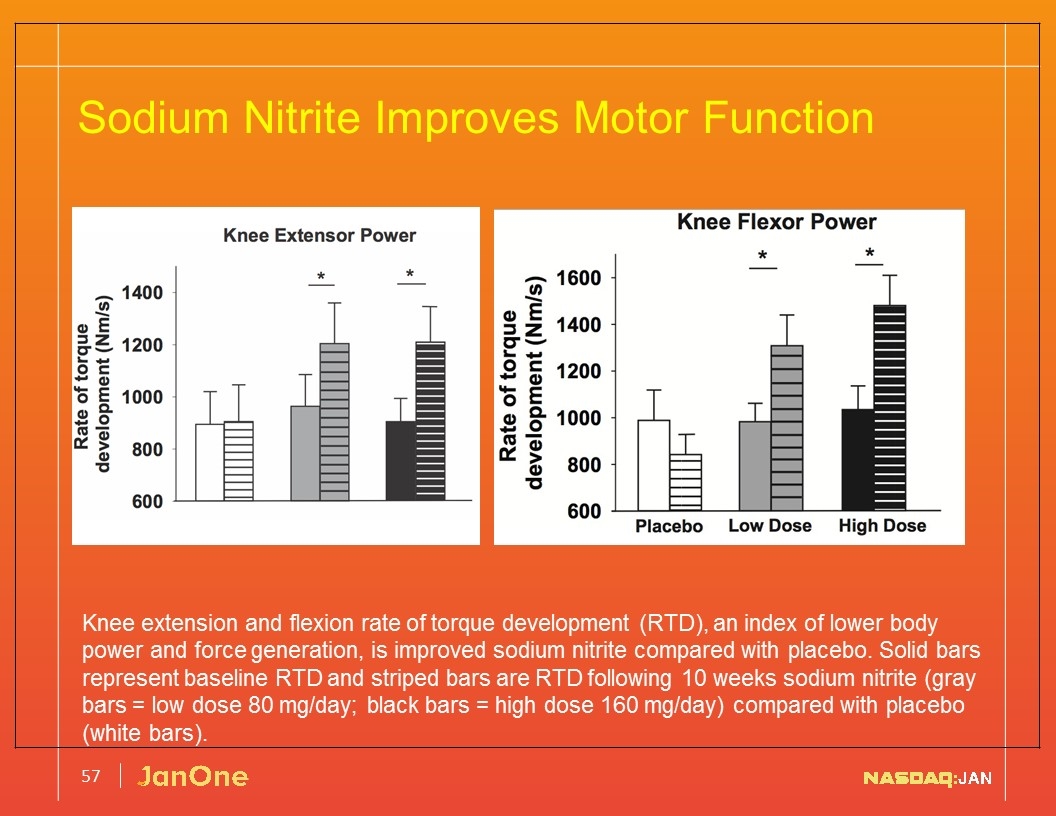
Sodium Nitrite Improves Motor Function Knee extension and flexion rate of torque development (RTD), an index of lower body power and force generation, is improved sodium nitrite compared with placebo. Solid bars represent baseline RTD and striped bars are RTD following 10 weeks sodium nitrite (gray bars = low dose 80 mg/day; black bars = high dose 160 mg/day) compared with placebo (white bars). 57

Sodium Nitrite Improves Secondary Indicators of Motor Function Improvements observed expressed as % change from baseline in secondary motor function outcomes following 10-week supplementation of sodium nitrite in healthy middle- aged and older adults. 58

Sodium Nitrite Improves Cognitive Function Time to complete the Trail Making Test part A (TMT-A) and part B (TMT-B) \ an index of processing speed and executive functioning, respectively, is improved sodium nitrite compared with placebo. Solid bars represent baseline and striped bars are TMT times following 10 weeks sodium nitrite (Low dose 80 mg/day, High dose 160 mg/day) compared with placebo. 59
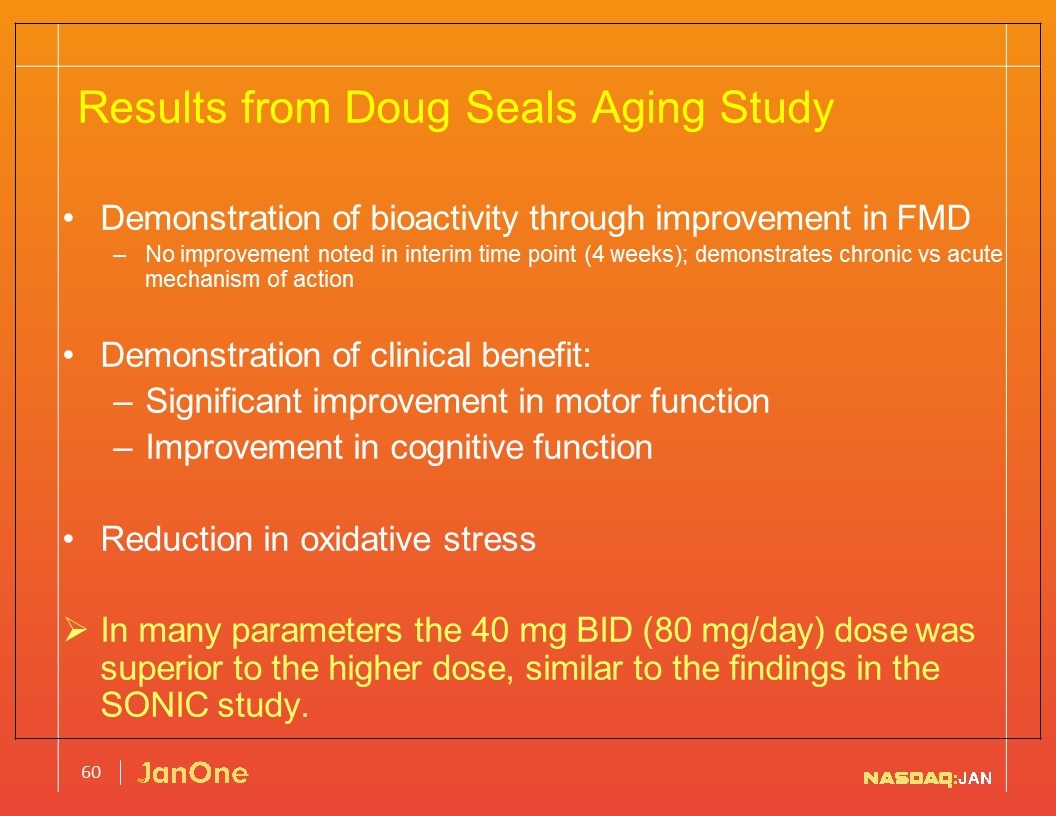
Results from Doug Seals Aging Study Demonstration of bioactivity through improvement in FMD No improvement noted in interim time point (4 weeks); demonstrates chronic vs acute mechanism of action Demonstration of clinical benefit: Significant improvement in motor function Improvement in cognitive function Reduction in oxidative stress In many parameters the 40 mg BID (80 mg/day) dose was superior to the higher dose, similar to the findings in the SONIC study. 60

Human Clinical Trials with Sodium Nitrite have been Initiated University of Colorado Study on Normal Aging 64 subjects, 60-79 yo, Randomized 1:1 (placebo:40 mg TV1001sr) 12 weeks, BID treatment Endpoints Vascular function improvement Motor function improvement Sensation improvement Cognitive improvement Changes in fMRI assessments of global and regional brain structure and task induced neural activation patterns during motor and cognitive tasks Diabetic Neuropathy Trial (Completed) 61

Diabetic Neuropathic Pain Study using Sustained Release Nitrite Rationale In SONIC study, subjects reported a significant reduction in pain. In a study carried out at NIH with topical nitrite and sickle cell patients with foot ulcers subjects reported significantly less pain. (ADD REFERENCE) Improving blood flow to the damaged neurons and reducing inflammation will likely lead to improved neuronal function and reduced pain. Most current therapies are Class 5 narcotics, Sustained Release Nitrite represents a non-addictive, cost effective method for treating pain. Pain Phase IIa Clinical Study Conducted at the Ohio Pain Clinic by Dr. Amol Soin Placebo vs 40 and 80 Sustained Release Nitrite, double blind 90 days BID Primary Endpoints – Safety, PK Reduction in blood pressure drop, headaches and dizziness Demonstration of sustained release profile Secondary Endpoints – Biological Activity Pain questionnaires Quantitative sensory pain scoring , 62

Placebo 40 mg group 80 mg group Number 9 7 8 Age, years (SD) 60.0 (13.1) 63.1 (11.8) 50.2 (9.8) Sex, male 5 (55.6%) 4 (57.1%) 3 (37.5%) Race, white 100% 100% 100% Ethnicity, white 100% 100% 100% Smoking Status Former 6 (66.7%) 3 (42.9%) 3 (37.5%) Current 0 1 (14.3%) 0 Peripheral Vascular Disease 0 1 (14.3%) 0 Cardiovascular Disease 6 (66.7%) 6 (85.8%) 3 (37.5%) HbA1c at screening (SD) 7.7 (1.4) 7.7 (1.2) 8.5 (2.4) Demographic Data No differences between treatment groups 63

Mean of: Total AEs Total SAEs Combined Placebo 29 2 40 mg TV1001 23 5 80 mg TV1001 23 2 F(2,23) .10 .13 p .905 .880 Safety Data: Adverse Events No differences in reported AEs or SAEs. All reported SAEs were not deemed to be treatment related. No reports of headaches or dizziness at either dose. 64

Preliminary Pharmacokinetic Data with Sustained Release Nitrite Note: Due to problems with sample prep, many samples were lost to analysis and data was therefore imputed. Pharmacokinetic analysis will need to be repeated. 10.73 31.99 47.52 33.95 14.1 9.24 18.78 14.1 29.09 49.43 34 22.65 14.217 3.89 3.89 3.89 3.89 3.89 3.89 3.89 0 10 20 30 40 50 60 0 30 60 180 240 360 CONCENTRATION 120 TIME Time - Concentration Plot JAN101 40 mg JAN101 80 mg Combined Placebo Arms 65

Effects of Sustained Release Nitrite on Neuropathic Pain Symptom Inventory Summary of Reported Treatment Effects on Pain V2V3% ChangeJAN101 Fold NPSIV1ChangeChangeof V3 toImprovement from V1from V1V1Over Placebo Placebo 47.4 C8.44 C4.00 8.4% Total 40 mg 34.7 C4.71 C4.43 12.7% 1.51 Score 80 mg 56.0 C1.88 C10.00 22.0% 2.62 66

Effects of Sustained Release Nitrite on Brief Pain Inventory Summary of Reported Treatment Effects on Pain V2V3Ch % geJAN101 Fold Brief Pain InventoryV1ChangeChangeanImprovement from V1from V1of V3 toOver Placebo V1 Placebo 5.1 D0.96 D0.24 5.9% Severity Score 40 mg 4.3 D1.06 D0.48 11.6% 1.97 80 mg 5.9 D0.54 D0.84 13.6% 2.34 Placebo 5.0 D0.57 D0.73 14.0% Interference 40 mg 4.4 D1.11 D0.20 4.5% D3.11 Score 80 mg 6.4 0.62 0.77 10.94% D1.28 67

Effects of Sustained Release Nitrite on McGill Pain Index Summary of Reported Treatment Effects on Pain McGill PainV1V2V3% ChangeJAN101 Fold IndexChangeChangeof V3 toImprovement from V1from V1V1Over Placebo Placebo 5.1 B1.4 B1.5 29.4% Total Score 40 mg 3.9 B0.7 B1.4 35.9% 1.22 80 mg 4.8 0.8 B0.2 4.2% B7.00 Placebo 5.0 B1.9 B1.8 36.0% Continuous 40 mg 3.7 B0.2 B1.7 48.6% 1.35 Pain 80 mg 4.4 1.2 B0.1 2.3% B15.7 Placebo 6.0 B1.6 B1.9 31.7% Intermittent 40 mg 4.6 B1.1 B1.8 39.1% 1.23 Pain 80 mg 5.9 0.7 B0.6 10.2% B3.11 68

Effects of Sustained Release Nitrite on Nerve Conductance and Velocity 10.0 9.0 8.0 7.0 6.0 5.0 4.0 3.0 2.0 1.0 0.0 Placebo 40 mg 80 mg Nerve Sensory Conductance Visit 1 Visit 2 Visit 3 40.0 30.0 20.0 10.0 0.0 70.0 60.0 50.0 Placebo 40 mg 80 mg Nerve Sensory Velocity Visit 1 Visit 2 Visit 3 Nerve Sensory Testing. The mean and standard deviations for Nerve Sensory Conductance and Nerve Sensory Velocity are shown for Visit 1 (baseline), Visit 2 and Visit 3 (end of the study) for the placebo group (n=9), 40 mg BID JAN101 treatment group (n=7) and 80 mg BID treatment group (n=8). 69

Phase II Diabetic Neuropathy Study Results with Sustained Release Nitrite No reports of headaches or dizziness. Cmax = ~0.8 uM, time to Cmax ~ 3 hours. 40 mg and 80 mg doses caused reduction in pain (when compared to placebo) in most questionnaires: Brief Pain Inventory (Severity):1.97X (40 mg), 2.34X (80 mg) Neuropathic Pain Symptom inventory:1.51X (40 mg), 2.62X (80 mg) McGill Pain Index (main subsections):1.22-1.35X (40 mg) 70

Clinical Trials Summary Trial PAD Aging Diabetic Neuropathy Formulation Sodium Nitrite Sodium Nitrite Sustained Release Nitrite N 55 30 26 Side Effects Headaches Headaches None FMD Improved Improved Not Measured NCV Not Measured Not Measured Improved (80 mg) Pain Reduced (40 mg) Not Measured Reduced Physical Functioning Improved (NS) Improved Not Measured 71
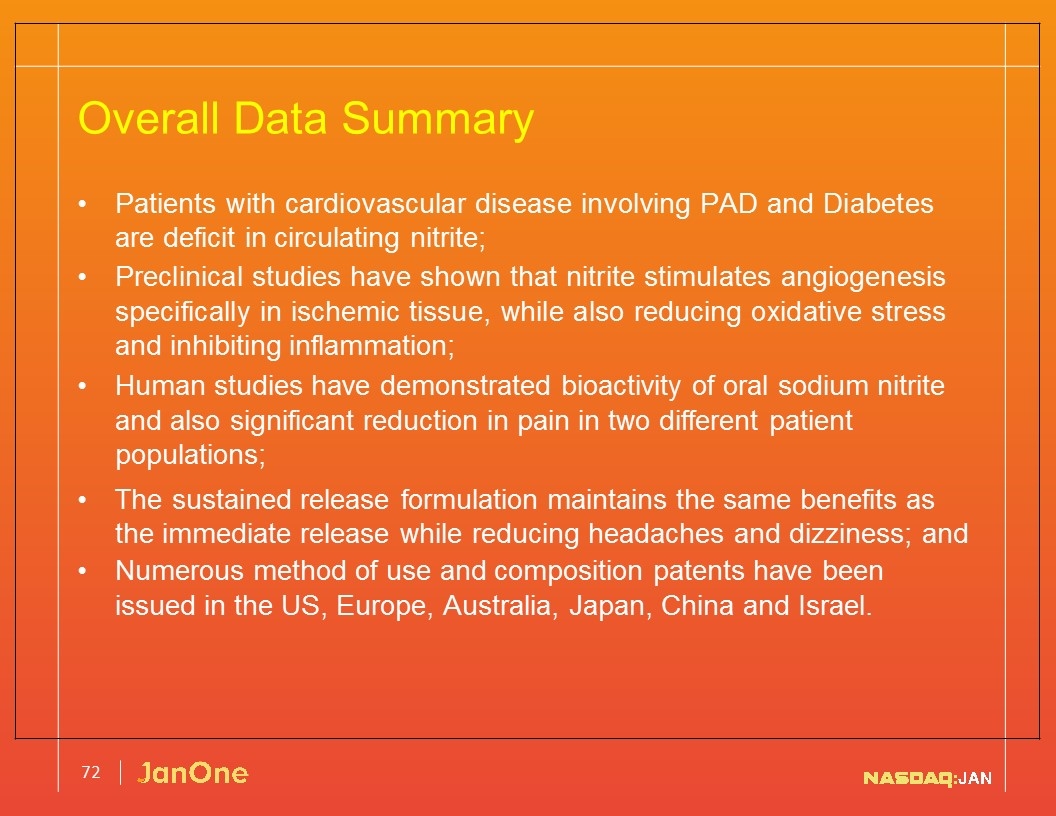
Overall Data Summary Patients with cardiovascular disease involving PAD and Diabetes are deficit in circulating nitrite; Preclinical studies have shown that nitrite stimulates angiogenesis specifically in ischemic tissue, while also reducing oxidative stress and inhibiting inflammation; Human studies have demonstrated bioactivity of oral sodium nitrite and also significant reduction in pain in two different patient populations; The sustained release formulation maintains the same benefits as the immediate release while reducing headaches and dizziness; and Numerous method of use and composition patents have been issued in the US, Europe, Australia, Japan, China and Israel. 72